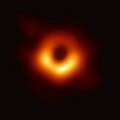Black hole bomb
A black hole bomb is the name given to a physical effect utilizing how a bosonic field impinging on a rotating black hole can be amplified through superradiant scattering. If the amplified field is reflected back towards the black hole, the amplification can be repeated, leading to a run-away growth of the field, i.e. an explosion. This explosion can be as powerful as a supernova. One way this reflection could be realized in nature is if the bosonic field has mass. The mass of the field can then cause the amplified modes to be trapped around the black hole, leading to an endless cycle of self-amplification. This is called a superradiant instability, as the amplified field can be generated out of noise, making the system inherently unstable. It can also refer to one such method of creating such a runaway effect, a Penrose sphere with no means for energy to passively escape.
History
[edit]The idea that angular momentum and energy may be transferred from a rotating black hole to a particle being scattered by it was proposed by Roger Penrose in 1971 (Penrose process). In 1972 Yakov Zel'dovich realised this was true also for waves with angular momentum being scattered by any rotating absorber, giving the example of electromagnetic waves scattering from a metal cylinder, and noted that by surrounding the system by a resonant reflector, the amplification effect could turn into generation.[1] The runaway effect in the astrophysical case was first explored by William H. Press and Saul Teukolsky in 1972, when they coined the phrase 'black hole bomb'.[2] If such an effect were to spontaneously occur, it may point to new physics beyond the Standard Model, and showing that black holes have "hair", as pointed out by a paper from 2017, by William E. East and Frans Pretorius.[3][4]
Black hole bomb type instabilities
[edit]Other systems may show black hole bomb instabilities, for example electromagnetic and acoustic systems.[5][6] In Zel'dovich's general rotational superradiance case, if the superradiant modes are confined around the absorber so they can re-amplify, and the loss from the system is lower than the amplification gain, the system becomes unstable. Noise generates an exponential increase in the amplitude of the superradiant modes, until the system either can no longer confine the mode energy (explodes), or the rotating body has lost sufficient energy to no longer meet the superradiance condition of the confined resonant modes. In 2025, the instablity was reported in an electromagnetic experiment.[7]
See also
[edit]References
[edit]- ^ Zel'dovich, Ya. B. (1971). "Generation of Waves by a Rotating Body" (PDF). JETP letters. 14: 180–181. Retrieved 2019-09-09.
- ^ Press, William H.; Teukolsky, Saul A. (1972). "Floating Orbits, Superradiant Scattering and the Black-hole Bomb". Nature. 238 (5361): 211–212. doi:10.1038/238211a0. ISSN 1476-4687. Retrieved 2022-08-22.
- ^ Sam Dolan (24 July 2017). "Viewpoint: Spinning Black Holes May Grow Hair". Physical Review Letters. American Physical Society.
- ^ Hamish Johnston (27 July 2017). "Spinning black holes could grow long hair". Physics World.
- ^ Cardoso, Vitor; Dias, Óscar J. C.; Lemos, José P. S.; Yoshida, Shijun (2004-08-26). "Black-hole bomb and superradiant instabilities". Physical Review D. 70 (4): 044039. arXiv:hep-th/0404096. doi:10.1103/PhysRevD.70.044039. Retrieved 2024-06-03.
- ^ Brito, Richard; Cardoso, Vitor; Pani, Paolo (2020). Superradiance: New Frontiers in Black Hole Physics. Lecture Notes in Physics. Cham: Springer International Publishing. ISBN 978-3-030-46622-0. Retrieved 2025-07-13.
- ^ Bischoff, Manon. "Physicists Have Built a 'Black Hole Bomb' in the Laboratory". Scientific American. Retrieved 2025-07-13.
Further reading
[edit]- Paolo Pani; Vitor Cardoso; Leonardo Gualtieri; Emanuele Berti; Akihiro Ishibashi (27 September 2012). "Black-Hole Bombs and Photon-Mass Bounds". Physical Review Letters. 109 (13): 131102. arXiv:1209.0465. Bibcode:2012PhRvL.109m1102P. doi:10.1103/PhysRevLett.109.131102. PMID 23030079. S2CID 15345273.
- William E. East; Frans Pretorius (24 July 2017). "Superradiant Instability and Backreaction of Massive Vector Fields around Kerr Black Holes". Physical Review Letters. 119 (4): 041101. arXiv:1704.04791. Bibcode:2017PhRvL.119d1101E. doi:10.1103/PhysRevLett.119.041101. PMID 29341737. S2CID 14572879.
External links
[edit]- Helvi Witek, 'Black Hole Bomb' Simulation on YouTube, Ole Miss News, University of Mississippi (12 October 2012)
- The Black Hole Bomb and Black Hole Civilizations. Kurzgesagt – In a Nutshell. 22 April 2018 – via YouTube.


 French
French Deutsch
Deutsch